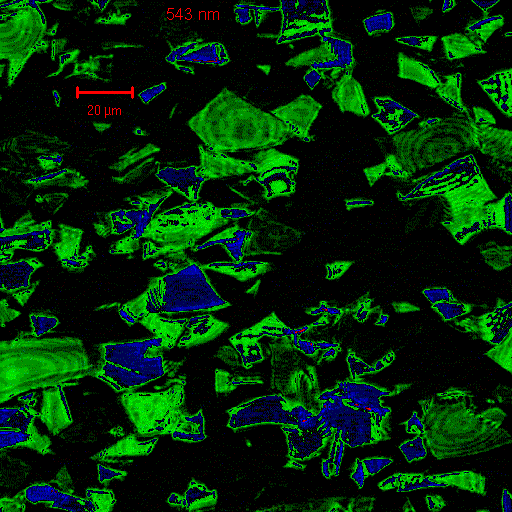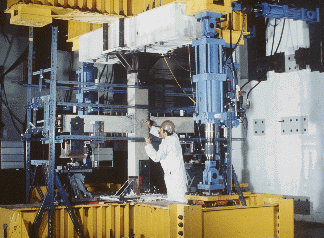|
|
|
|
|
|
|
|
|
|
|
|
 |
 |
 |
 |
|||||||
|
|
||||||||||
 |
 |
 |
 |
 |
 |
 |
 |
|||
Building and Fire Research Laboratory
Materials and Construction Research Division
PHOTO:Innovative precast beam-column connections undergoing psuedo-earthquake motion in the
Tri-directional Test Facility.The MATERIALS AND CONSTRUCTION RESEARCH DIVISION serves as the world-class resource for developing and promoting the use of science-based tools – measurements, data, models, protocols, and reference standards – to enhance (a) the global competitiveness of U.S. industry through innovations in building materials and construction technology, and (b) the safety, security, and sustainability of the nation’s buildings and physical infrastructure. The division: (1) develops and implements computational, theoretical, and experimental methods to predict and optimize the service life performance and cost of advanced materials used in construction, including pigments, cement, concrete, polymers, metals, and composites; (2) provides science-based measurement and predictive tools and protocols for advanced construction technologies – innovative connections, high-performance constructed systems, and process technologies for automated construction – to enhance productivity, safety, security, and life-cycle performance; (3) conducts technical investigations of structural failures, including failures during construction or following natural, terrorist, and technological disasters; (4) provides technical support to national and international standards and codes development and professional practice organizations; (5) conducts cooperative programs with other federal and state agencies, industry, professional societies, testing laboratories, educational institutions, and other research organizations; and (6) supports the scientific and technical information needs of federal agencies in formulating national policies related to building and infrastructure applications.
Jon Martin, Chief (301) 975-6717
jonathan.martin@nist.govRESEARCH AREAS
High Performance Construction Materials and Systems
Research Programs
- CONSIAT: Construction Integration and Automation Technology -- To achieve significant cycle time and life-cycle cost reductions in the delivery of construction projects by 2004 through the integration and automation of project information, and the integration of metrology data and other information from the construction site into project information management systems.
- SLP Program -- to develop scientific methods, in partnership with industry, for measuring and predicting the service life of polymeric building materials.
- HYPERCON Program -- in partnership with industry, to develop, demonstrate, disseminate, and assist with implementation of a computer-integrated knowledge system, HYPERCON, including validating multi-attribute simulation models for prediction and optimization of concrete performance taking into account life-cycle costs and environmental impact.
These programs benefit from collaborations with other BFRL divisions, divisions in other NIST laboratories, industry sponsors, and other government agencies.Homeland Security
Research Programs
- Research and Development for the Safety of Threatened Buildings -- To provide a technical foundation that supports improvements to building and fire codes, standards, and practices which reduce the impact of extreme threats to the safety of buildings, their occupants and emergency responders.
DIVISION ORGANIZATION
Structures Group
Provides performance prediction tools to reduce the vulnerability of building and infrastructure systems to extreme events (e.g., wind, fire, earthquake, impact, blast) through cost-effective reliability-based multi-hazard approaches. The group: (1) conducts laboratory, field, and analytical research in the areas of wind engineering, structural fire safety design and retrofit, mitigation of progressive structural collapse, nondestructive evaluation, and performance of structural materials and connections; (2) provides guidance, tools, and science-based criteria for vulnerability assessment, design, and retrofit applications; (3) conducts disaster and failure investigations; and (4) supports the technical information needs of federal agencies in formulating national policies related to building and infrastructure applications.
Stephen Cauffman, Leader
(301) 975-6051
cauffman@nist.govConstruction Metrology and Automation Group
Provides measurement systems and protocols to integrate and automate the construction process to achieve construction cycle time and cost reductions. The group: (1) conducts laboratory, field, and analytical research in site metrology and wireless information transfer, supply chain and inventory tracking technologies, precision tele-operable and autonomous processes, automated steel and concrete construction, and next-generation field sensing (RFID, MEMs, LADAR) and object recognition systems; (2) develops and provides performance metrics, criteria, and artifact traceable calibration services for construction measurement systems; (3) provides construction process simulation and 3D visualization tools; (4) develops and provides sensor interface and other protocols to achieve seamless information integration; and (5) provides demonstrations of advanced measurement systems and information protocols for industry adoption and use.
Alan Lytle, Leader
(301) 975-6048
alan.lytle@nist.govInorganic Materials Group
C-S-H Cement Paste Concrete

Set of figures showing real (upper) and model (lower) images of the length scales of concrete from nanometer level structure (C-S-H) to millimeter level concrete structure. Develops and implements computational and experimental materials science-based techniques to enable the prediction and optimization of service life performance and life-cycle cost of cement, concrete, and other inorganic materials. The group: (1) performs computational and experimental materials science of cement and concrete, linking together molecular dynamics, nanostructure, and microstructure over six orders of magnitude to quantitatively predict performance from fundamental science; (2) applies these accurate performance prediction models to the optimization of cement and concrete for use in the built environment; (3) provides models, computerized databases, and database mining techniques for storing, retrieving, and analyzing measurement data on properties of inorganic materials; (4) provides technical bases for improved criteria and standards for evaluation, selection, and use of these materials; and (5) supports the scientific information needs of federal agencies in formulating national policies related to building and infrastructure applications.
Edward Garboczi, Leader
- An Electronic Monograph: Modeling and Measuring the Structure and Properties of Cement-Based Materials
- Virtual Cement and Concrete Testing Laboratory (VCCTL)
- Concrete Optimization Software Tool
- Computer Integrated Knowledge System for High Performance Concrete
(301) 975-6708
edward.garboczi@nist.govPolymeric Materials Group

Laser scanning confocal microscope image of a coating containing interference pigments. In this image, green laser light was used. Interference fringes are observed for some pigments, where as other pigments that are transparent to green light are not visible in this image but are observed under different laser light. Develops and implements methodologies and metrologies for determining the scientific origins of materials degradation required for predicting the service life of polymeric materials, components, and systems exposed in their intended or accelerated exposure environments. The group provides: (1) measurements at the molecular and nanometer scales of chemical, physical, mechanical, optical, and morphology property changes in polymeric materials as they degrade; (2) develops instrumentation and sensors for automating the formulation, material property characterization, and accelerated aging of polymeric materials; (3) conducts analytical, laboratory, and field research on the performance of polymeric materials such as coatings, sealants, adhesives, composites, and roofing materials; (4) provides technical bases for improved criteria and standards for evaluation, selection, and use of these materials; and (5) supports the scientific information needs of federal agencies in formulating national policies related to building and infrastructure applications.
Joannie Chin, Leader
- Appearance of Polymeric Coatings
- Interfaces and Interphases in Polymeric Materials and Systems
- Service Life Prediction of Polymeric Coatings
- Service Life Prediction of Sealant Materials
301-975-6815
joannie.chin@nist.gov
|
Privacy Policy/Security Notice/Accessability | Disclaimer | FOIA NIST is an agency of the U.S. Department of Commerce |

|
Last updated: 1/18/2008
